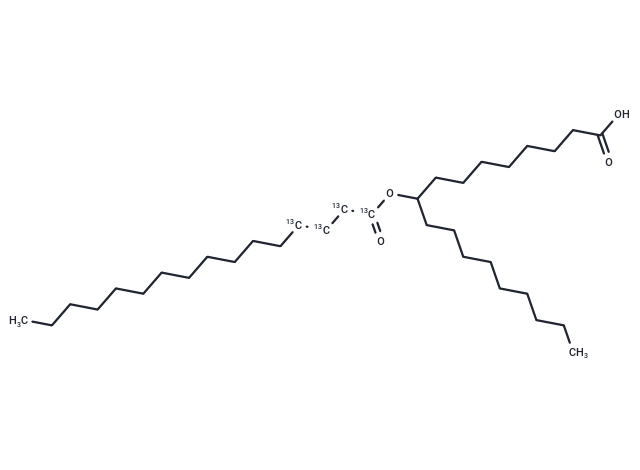 您的购物车当前为空
您的购物车当前为空
9-PAHSA 13C4
一键复制产品信息Branched fatty acid esters of hydroxy fatty acids (FAHFAs) are a class of endogenous lipids whose levels are modulated by fasting and high-fat diets, and they play a role in insulin sensitivity. These compounds consist of a fatty acid—either a C-16 or C-18, such as palmitoleic, palmitic, oleic, or stearic acid—esterified to a hydroxylated C-16 or C-18 lipid. One notable FAHFA, 9-PAHSA, features an ester linkage between palmitic acid and 9-hydroxy stearic acid. PAHSAs, with 9-PAHSA being the most prevalent isomer, are significantly found in the serum and both white and brown adipose tissues of glucose-tolerant AG4OX mice, which express the Glut4 gene in adipose tissue, enhancing insulin sensitivity. Additionally, 9-PAHSA is abundant in wild type and AG4OX mice and present in humans, though at reduced levels in those with insulin resistance. 9-PAHSA is associated with improved glucose tolerance, enhanced insulin secretion, and anti-inflammatory effects in mice. The compound 19-PAHSA^13C4 represents an isotopically enriched form of this polyunsaturated fatty acid.

9-PAHSA 13C4
一键复制产品信息Branched fatty acid esters of hydroxy fatty acids (FAHFAs) are a class of endogenous lipids whose levels are modulated by fasting and high-fat diets, and they play a role in insulin sensitivity. These compounds consist of a fatty acid—either a C-16 or C-18, such as palmitoleic, palmitic, oleic, or stearic acid—esterified to a hydroxylated C-16 or C-18 lipid. One notable FAHFA, 9-PAHSA, features an ester linkage between palmitic acid and 9-hydroxy stearic acid. PAHSAs, with 9-PAHSA being the most prevalent isomer, are significantly found in the serum and both white and brown adipose tissues of glucose-tolerant AG4OX mice, which express the Glut4 gene in adipose tissue, enhancing insulin sensitivity. Additionally, 9-PAHSA is abundant in wild type and AG4OX mice and present in humans, though at reduced levels in those with insulin resistance. 9-PAHSA is associated with improved glucose tolerance, enhanced insulin secretion, and anti-inflammatory effects in mice. The compound 19-PAHSA^13C4 represents an isotopically enriched form of this polyunsaturated fatty acid.
| 规格 | 价格 | 库存 | 数量 |
|---|---|---|---|
| 10 mg | 待询 | 8-10周 | |
| 50 mg | 待询 | 8-10周 |
9-PAHSA 13C4 相关产品
产品介绍
| 产品描述 | Branched fatty acid esters of hydroxy fatty acids (FAHFAs) are a class of endogenous lipids whose levels are modulated by fasting and high-fat diets, and they play a role in insulin sensitivity. These compounds consist of a fatty acid—either a C-16 or C-18, such as palmitoleic, palmitic, oleic, or stearic acid—esterified to a hydroxylated C-16 or C-18 lipid. One notable FAHFA, 9-PAHSA, features an ester linkage between palmitic acid and 9-hydroxy stearic acid. PAHSAs, with 9-PAHSA being the most prevalent isomer, are significantly found in the serum and both white and brown adipose tissues of glucose-tolerant AG4OX mice, which express the Glut4 gene in adipose tissue, enhancing insulin sensitivity. Additionally, 9-PAHSA is abundant in wild type and AG4OX mice and present in humans, though at reduced levels in those with insulin resistance. 9-PAHSA is associated with improved glucose tolerance, enhanced insulin secretion, and anti-inflammatory effects in mice. The compound 19-PAHSA^13C4 represents an isotopically enriched form of this polyunsaturated fatty acid. |
| 分子量 | 542.9 |
| 分子式 | C30[13C]4H66O4 |
| CAS No. | 2748638-71-1 |
| 存储 | Powder: -20°C for 3 years | In solvent: -80°C for 1 year | Shipping with blue ice/Shipping at ambient temperature. |





 还可以
还可以

 |
|
评论内容